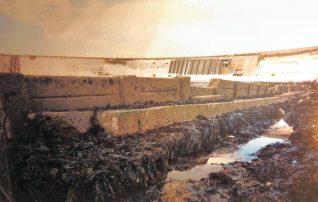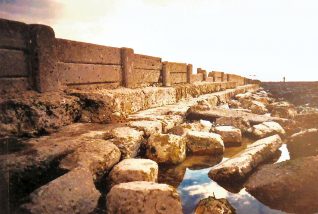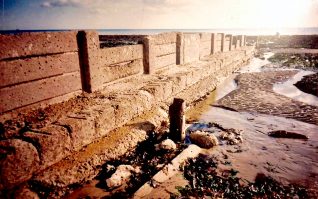Changes over time



Construction started 1928
The Undercliff has seen a few changes over the generations. Some have been sudden and relatively quick, such as the initial Undercliff Walk construction of 1928-1935, and the recent major rebuild we enjoy today. There has been other, less dramatic and more gradual change.
Groynes date from c1906
These photos taken in 2003 show the wonderful inter-tidal stretch of coast off Ovingdean Gap. The two groynes are the sole survivors of nineteen that once stood between Roedean and Saltdean. Dating from 1906-1911, these pre-date the Undercliff Walk itself, and had in fact been the first reinforced concrete groynes in England. I think it is incredible these sections have withstood the sea for a century.
Easy access to the sea
Over the years, they’ve been handy to sit on, or sit against, for a sunbathe. Since childhood not only have they been fun to walk along, but have provided relatively easy access to the sea at the very lowest of tides for a paddle and some rewarding “rockpooling”. Excellent views of the coast, too, have been possible from them. Now in rapid deterioration, these century-old walls will eventually disappear, perhaps sooner rather than later … who knows?
Do you remember?
Did you ever go ‘rockpooling’? Please share your memories by posting below.




Comments about this page
As a kid in the 40s and 50s I spent untold hours along the Undercliff Walk and playing among the so-interesting rock pools. In season I would collect winkles for Sunday tea. The beaches were not so good for swimming as the rocks were a bit sharp in places. The undercliff was a wild place when there was a storm going on, I used to get drenched as the sea hit the wall and sent great spurts of water in the air and over onto the promenade. Further out were the remnants of the Daddy Long Legs rail line. These were large blocks of concrete which held the rail lines in place. My kids also enjoyed playing among the rocks and discovering the life in the pools. We did not go winkling too much as, if I remember, there seemed to be a ban on winkling some time in the 70s. Anyway the place is a vivid memory for myself when I was young and I loved it, never forgot it.
I believe the construction of the concrete groynes was to build up the shingle to the bottom of the cliff to stop the erosion that would threaten the main coast road and sewer that ran out to Portabello. Sadly the construction of the many groynes between Roedean and Rottingdean closed the Daddy Longlegs railway, this was because of the costly diversion involved in re-routing the rails further out past the length of the new groynes.
Thanks, I’ve enjoyed these comments. Your recollections, Mick, date from when there were many secluded beaches: in rough weather the sea would hit the wall with a deep boom and spray out in a dramatic way not seen so often now. I’ve often found rock-pooling especially good around the railway blocks. Michael, you made important points. I see from a 1912 paper by Owens & Wood that the groynes were each in the region of a whooping 500 ft. out to sea – imagine the labour and working conditions involved! The lower photo shows a surviving stump of one of the electricity poles, well-illustrating how the line needed to be diverted, were it to continue.
I remember going with my dad to collect winkles at low tide and then eat them with a pin.
Add a comment about this page